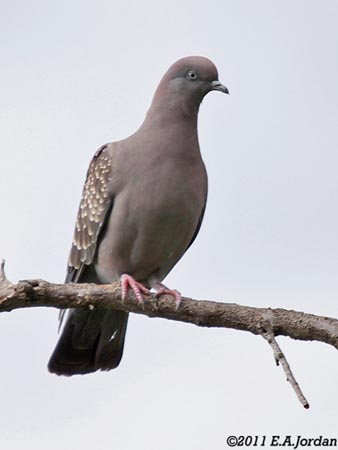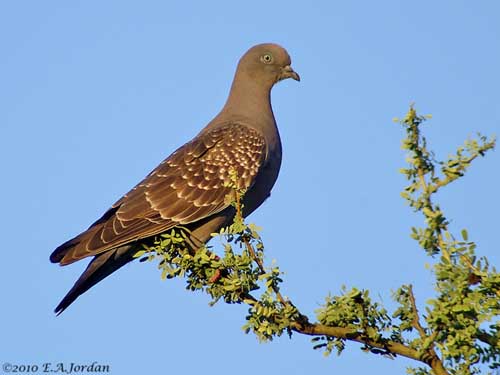
Fr: Pigeon tigré
All : Fleckentaube
Esp: Paloma Moteada
Ital: Colomba macchiata del Sudamerica
Nd: Vlekduif
Sd: Fläckduva
Port: Pomba-do-orvalho
Photographers :
Jean Michel Fenerole
Photos d’Oiseaux du monde
Eduardo Andrés Jordan
MIS AVES – AVES DE ARGENTINA
Philippe et Aline Wolfer
GALERIE
Text by Nicole Bouglouan
Sources :
HANDBOOK OF THE BIRDS OF THE WORLD vol 4 by Josep del Hoyo-Andrew Elliott-Jordi Sargatal - Lynx Edicions - ISBN: 8487334229
PIGEONS AND DOVES by David Gibbs, Eustace Barnes and John Cox - Pica Press Sussex - ISBN: 1873403607
BirdLife International (BirdLife International)
Wikipedia, la enciclopedia libre
Spot-winged Pigeon
Patagioenas (Columba) maculosa
Columbiforme Order – Columbidae Family
BIOMETRICS:
Length: 33 cm
Weight: 308-345 g
DESCRIPTION:
The Spot-winged Pigeon is a South American species often seen in small groups. The genus Patagioenas is used for the American species.
The adult male has dark brown mantle and wing-coverts. All feathers show a whitish spot on tip, involving spotted effect. The outer greater coverts are bluish-grey, the outermost have white edges. Primary and secondary flight feathers are black, narrowly edged white. Lower back, rump and uppertail-coverts are bluish-grey. The tail is dark grey with black terminal band. Plumage colour may vary according to the light.
On the underparts, the breast is dull purplish-pink. Rest of underparts is grey with purplish-pink wash, except on flanks, belly and undertail-coverts. The underwing is pale grey.
On the head, forehead, crown, nape and hindneck are mainly dull purplish-pink. The rest of the head is grey.
The bill is blackish with white cere. The eyes may vary from grey to white. Legs and feet are reddish.

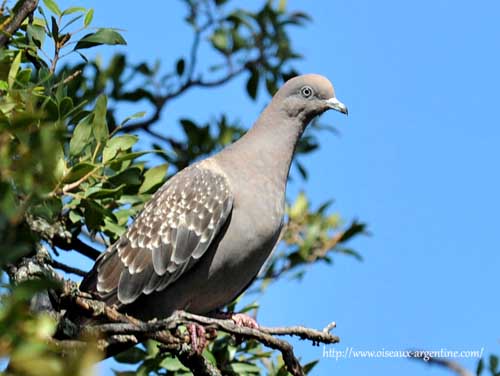
Both sexes are similar, but female has duller head and neck.
The juvenile is duller overall, with dull grey head and breast.
We can find two subspecies:
P.m. maculosa (here described and displayed) is found in extreme S Bolivia, Paraguay, SE Brazil and Uruguay, S to SC Argentina.
P.m. albipennis is found in C Peru (Lima), S to W and C Bolivia and extreme NW Argentina. This one shows conspicuous white wingbar contrasting with the dark flight feathers. The upperwing is rather finely scaled than spotted. Foreneck and breast show more vinous wash.
VOICE: SOUNDS BY XENO-CANTO
The Spot-winged Pigeon gives soft coos which can be followed by series of coarse “rrrooo-rroo-rroo”. We can also hear a much louder, slightly raucous “caarrr, cuk, caarr, caarr”.
During displays, it utters series of low growling calls.
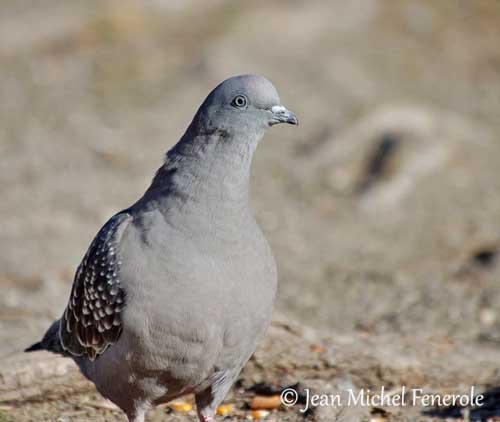
HABITAT:
The Spot-winged Pigeon frequents arid to semi-arid open woodland and scrub, often near cultivated fields. It can be seen near villages and sometimes in small Eucalyptus thickets.
The race “albipennis” can be found up to 2000-4200 metres of elevation on Andean slopes, while the nominate race occurs at least up to 1000 metres.
RANGE:
See above in “subspecies”
BEHAVIOUR:
The Spot-winged Pigeon feeds primarily on seeds of cereals crops, grains and grasses. It also consumes buds, shoots, young leaves, and it probably takes fallen fruits too.
This species feeds mainly on the ground, often in pairs or in small groups. Outside the breeding season, they may form large flocks.
In Argentina, this pigeon is regarded as a pest when it attacks the sunflower crops.
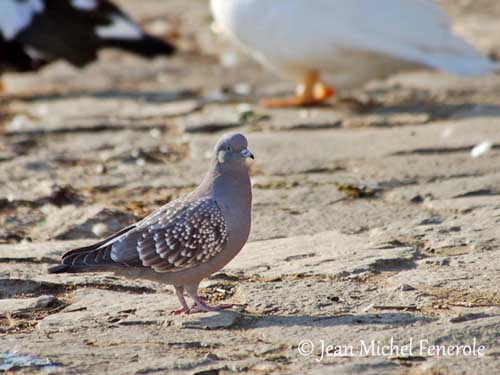
The Spot-winged Pigeon nests in Eucalyptus plantations and thickets near villages. The nest is built in tall tree.
The male performs the usual displays of Columbidae, a series of bows with quivering wings in front of the female. Another display shows the male fanning and raising the tail with the wings slightly held out.
From some observations, there is a third display during which the male rushes at the female while its plumage is fluffed out, the head lowered and the tail partially fanned.
Displays are usually followed by copulation.
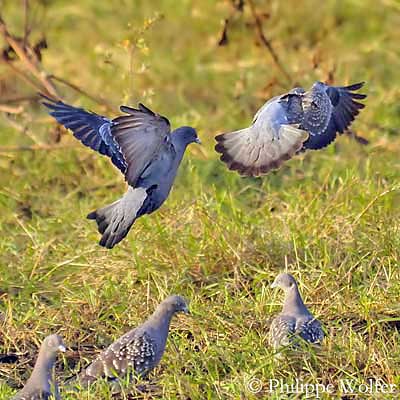
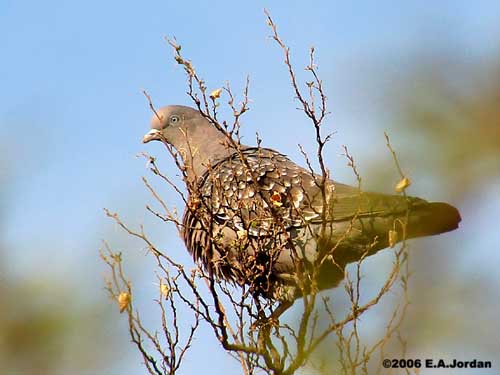
This species is migratory in Brazil, and mainly sedentary in the other parts of its range.
FLIGHT:
The Spot-winged Pigeon has powerful flight performed with rapid wingbeats.
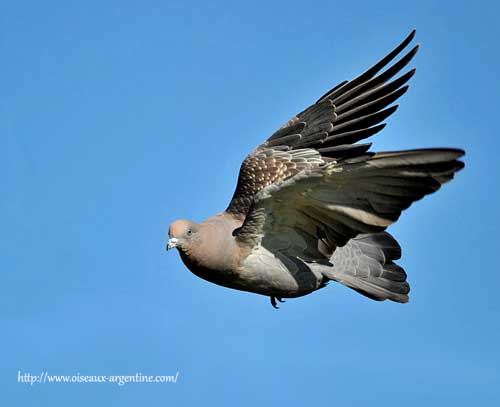
REPRODUCTION:
Breeding season appears active throughout the year.
The nest of the Spot-winged Pigeon is placed in tall tree in wooded area or thickets and in largely open area.
This is a flimsy platform made with twigs.
The female lays two white eggs and incubates. Chicks are fed by both parents by regurgitation of “crop-milk”, a very nutritious substance typical of Columbidae. The juveniles are fed until their first flight.
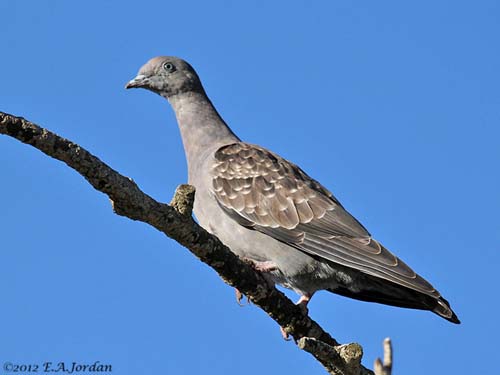
DIET:
The Spot-winged Pigeon feeds mostly on seeds of cereals, grains and grasses. It also takes a variety of greenery such as buds, shoots and young leaves, and some fallen fruits.
This species feeds on the ground.
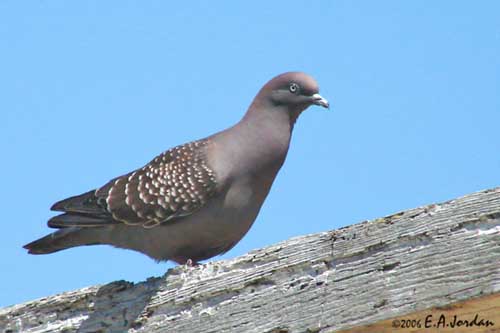
PROTECTION / THREATS / STATUTS:
The Spot-winged Pigeon is widespread and common in most parts of its range. It is more locally distributed on plateaux in Andean valleys and on W slopes of Andes in Peru.
This species is expanding in Argentina where it is considered a pest when it attacks the sunflower crops.
The species is not currently threatened.
